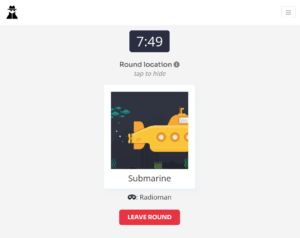

This week, we played Spyfall. It was originally a card game for 3-8 players designed by Alexandr Ushan and published in 2014 by Hobby World, and we played a digitized version (which expands the boundary of the game beyond the confines of a single room and allows people to play virtually – e.g., over zoom) that largely functioned the same way. The game is designed for ages 12 and up, and it appears to be designed for large social gatherings and kickbacks. The mechanics are quite straight forward and mirror those of similar social deception games like Mafia and Werewolf. It is a unilateral competition game in which a subset (the “spy”) is competing with the larger group of the players for victory. In the game, each player receives a card. Everyone gets a picture of the same location except for one person, who gets the “Spy” card (I’ve inserted pictures of the two card types below). During the 6 to 10-minute round, everyone takes turns asking another person questions to try to guess who knows the location or who the spy might be. At any point, the spy may reveal themselves and guess the location if they believe they have determined it. Anyone may also accuse someone of being the spy during or after the round. If the majority agree, and that person is in fact the spy, then the collective wins. Otherwise, the spy wins.
We played a modified version of the game with slightly tweaked rules and procedures. For example, we were only allowed to ask yes/no questions. We also let the round timer lapse (i.e., the spy didn’t reveal themselves to guess the specified location, and no one accused another player of being a spy mid-game). There was no debate on who the spy might be at the end of the round; instead, we pointed at who we thought the spy was on the count of three.
These restrictions – especially the yes/no question rule – made the game a little challenging. Figuring out the right question that wasn’t too obvious but specific enough that it would be helpful was tricky and ended up taking much of the round time. As a result, we didn’t really get to experience interesting play dynamics. I also feel like I didn’t get to see fun/interesting behaviors from the people I was playing with in a way that would have revealed a little more about who they are. So, in that regard, the game fell flat with respect to the fellowship elements you might see in comparable games, like a more interactive version of mafia or secret Hitler. I also think the stakes felt a lot lower than they did in a game like mafia where you’re dealing with murder, so I felt like my sense of fantasy and narrative wasn’t fully appealed to. I think in a future iteration I would definitely prefer to play it closer to the original rules, but I would also suggest adding a game master that could weave a narrative around the location. Maybe you’re on a quest and you and your team have to get to this location to save a person in distress before the spy gets to them. Maybe it’s the location of buried treasure. Something like that might enhance the fantasy and narrative aspects of the experience to make it more fun.
Ultimately the game could’ve been more fun and there were a few noteworthy moments. For example someone asked if it was socially acceptable to be drunk at a train station and that was a clever way to suss out the spy. However, the rounds moved quite slowly and with quite low action, so it didn’t feel particularly fun or energizing.
In one round some of the questioning about the school made the location a little obvious (I believe the question was “are you a teacher at this location”), but the game largely went without any glaring failures – which I think was part of the problem. There were no friction or funny experiences to sort of teach us new ways to play the game.



